Email marketing remains one of the most effective channels for businesses to engage with their audience. However, the success of email campaigns hinges on one critical factor: email deliverability. Understanding and optimizing email deliverability is essential for ensuring that your messages reach your subscribers’ inboxes, driving engagement and achieving your marketing goals. In this comprehensive guide, we’ll explore what email deliverability is, why it matters, key factors that influence it, and actionable strategies to improve it. We’ll also delve into how advanced tools like Prism Reach can enhance your email marketing efforts.
Understanding Email Deliverability
Email deliverability refers to the ability of an email to successfully land in the recipient’s inbox rather than being filtered into spam or rejected altogether. It’s not just about whether an email is sent; it’s about ensuring it reaches its intended destination and is opened and engaged with by the recipient. High deliverability rates are crucial for the effectiveness of email marketing campaigns, impacting open rates, click-through rates, and overall return on investment (ROI).
Upgrade Your Email Marketing with AI Personalization!
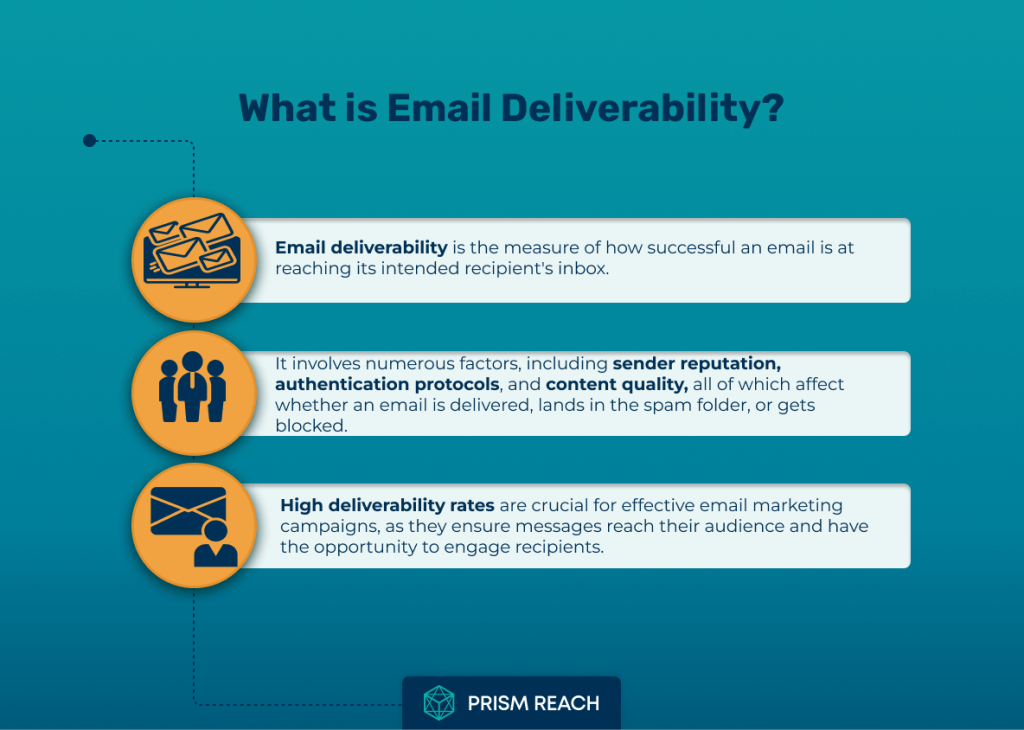
Why is Email Deliverability Important?
Email deliverability is the lifeblood of email marketing. Without it, even the most well-crafted campaigns can fail to achieve their objectives. Here’s why deliverability is so crucial:
- Protects Sender Reputation: Maintaining good deliverability practices helps safeguard your sender reputation, which is vital for long-term email success.
- Maximizes Audience Reach: Ensures that your messages reach as many subscribers as possible, increasing the potential for engagement.
- Enhances Engagement Rates: Higher deliverability leads to more emails being opened and interacted with, fostering stronger relationships with your audience.
- Boosts ROI: Effective deliverability translates to better performance metrics, making your email marketing efforts more cost-effective.
Key Deliverability Factors
Several factors influence email deliverability. Understanding these can help you implement strategies to improve your email performance:
1. Sender Reputation
Your sender reputation is a score that Internet Service Providers (ISPs) assign based on your email sending behavior. It reflects how trustworthy your emails are and determines whether your messages land in the inbox or spam folder. Key elements that influence sender reputation include:
- Sending Volume: Consistent sending volumes help build trust. Sudden spikes can raise red flags.
- Spam Complaints: High rates of spam complaints negatively impact your reputation.
- Bounce Rates: Frequent hard bounces indicate poor list hygiene and can damage your reputation.
- Engagement Rates: Higher open and click-through rates signal to ISPs that your content is valuable.
- Blacklisting: Being listed on spam blacklists severely hampers deliverability and requires immediate remediation.
Maintaining a strong sender reputation involves consistent monitoring and adherence to best practices. Tools like Prism Reach can help monitor your reputation in real-time, allowing you to take proactive measures to maintain high standards.
2. Authentication Protocols
Implementing authentication protocols like SPF (Sender Policy Framework), DKIM (DomainKeys Identified Mail), and DMARC (Domain-based Message Authentication, Reporting & Conformance) is essential for verifying your identity as a sender. These protocols help prevent your emails from being spoofed and increase trust with ISPs by:
- SPF: Specifies which mail servers are authorized to send emails on behalf of your domain, reducing the risk of spoofing.
- DKIM: Adds a digital signature to your emails, allowing ISPs to verify that the content hasn’t been altered during transit.
- DMARC: Provides instructions to ISPs on how to handle emails that fail SPF or DKIM checks, enhancing your domain’s security.
Properly configuring these protocols not only boosts deliverability but also protects your brand’s integrity. Prism Reach simplifies the setup process, ensuring that your authentication protocols are correctly implemented and maintained.
3. List Hygiene
Maintaining a clean and engaged email list is crucial for high deliverability. Regularly removing inactive or invalid email addresses reduces bounce rates and improves overall deliverability. Effective list hygiene practices include:
- Regular Cleaning: Periodically remove hard bounces, inactive subscribers, and invalid email addresses.
- Engagement Monitoring: Identify and re-engage inactive subscribers or remove them to maintain a healthy list.
- Double Opt-In: Use double opt-in methods to ensure that subscribers genuinely want to receive your emails.
- Preference Centers: Allow subscribers to manage their preferences, reducing the likelihood of unsubscribes and spam complaints.
Prism Reach offers advanced lead enrichment and list management features that automate the cleaning process, ensuring your list remains up-to-date and engaged.
4. Content Quality
High-quality, relevant content encourages recipients to engage with your emails. ISPs monitor engagement metrics to determine the value of your emails, affecting your deliverability. Key aspects of content quality include:
- Relevance: Tailor your content to meet the interests and needs of your audience segments.
- Engagement: Use compelling subject lines and engaging body content to increase open and click-through rates.
- Design: Ensure your emails are well-designed, mobile-responsive, and visually appealing.
- Personalization: Personalize content based on subscriber data to enhance relevance and engagement.
- Compliance: Adhere to email marketing laws and regulations to avoid legal issues and maintain trust.
Prism Reach’s AI-powered personalization features help create highly relevant and engaging content, boosting your engagement rates and deliverability.
5. Sending Practices
Consistent sending patterns, appropriate send frequency, and respecting subscriber preferences contribute to better deliverability. Key sending practices include:
- Consistent Schedule: Maintain a regular sending schedule to build trust and expectation among subscribers.
- Optimal Frequency: Balance your send frequency to avoid overwhelming subscribers while keeping them engaged.
- Respect Preferences: Honor unsubscribe requests promptly and provide options for subscribers to adjust their preferences.
- Gradual Volume Increases: When ramping up email volume, do so gradually to avoid triggering spam filters.
- Avoiding Spam Triggers: Refrain from using spammy language and excessive promotional content that can trigger filters.
Prism Reach helps manage sending practices by providing tools to optimize send times and frequencies based on subscriber behavior, ensuring your emails are well-received.
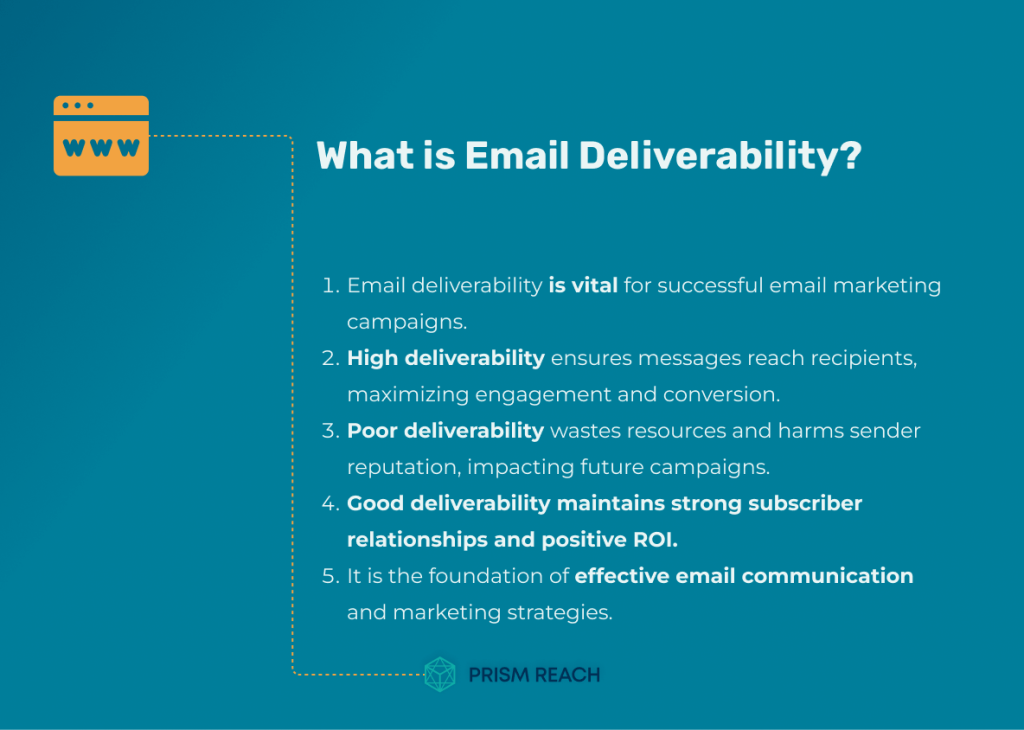
Hidden Gems: Advanced Strategies for Improving Email Deliverability
Beyond the fundamental practices, several lesser-known but highly effective strategies can significantly enhance your email deliverability. Here are five hidden gems to consider:
1. Implement Tiered Engagement Segmentation
Segment your email list based on subscriber engagement levels. A tiered system might involve sending:
- 70% of Campaigns: To highly engaged subscribers who frequently open and interact with your emails.
- 20% of Campaigns: To a broader audience with unique content tailored to varying levels of engagement.
- 10% of Campaigns: To your entire list for major promotions or announcements.
This targeted approach ensures that your most engaged subscribers receive the content most relevant to them, boosting overall engagement and deliverability.
2. Utilize Email Interaction Simulation
Tools like InboxAlly simulate genuine engagement activities with your emails, such as opening, marking as important, and moving emails from spam to the primary inbox. This helps improve your sender reputation and optimize delivery strategies by:
- Enhancing Engagement Metrics: Simulated interactions can improve your overall engagement statistics.
- Testing Deliverability: Allows you to test how your emails perform across different ISPs.
- Identifying Issues: Helps pinpoint deliverability problems before they affect your entire campaign.
Prism Reach can integrate with such simulation tools to provide a comprehensive deliverability optimization solution.
3. Leverage Provider-Specific Open Rate Analysis
Monitor open rates across different email providers. Significant discrepancies (e.g., 35% for Gmail but only 12% for Outlook) can indicate deliverability issues with specific providers. Addressing these discrepancies involves:
- Provider-Specific Content Optimization: Tailor your content to meet the preferences of different email providers.
- Sender Reputation Management: Focus on improving your reputation with providers showing lower open rates.
- Technical Adjustments: Ensure that your authentication protocols are correctly configured for each provider.
Prism Reach’s analytics tools can help identify and analyze these discrepancies, enabling targeted improvements.
4. Adjust Sending Frequency to Human Rates
Modify your email sending frequency to mimic human-like rates rather than relying on conventional bulk sending techniques. This strategy can involve:
- Gradual Scaling: Increase email volume gradually to match natural human sending patterns.
- Personalized Send Rates: Adjust send frequencies based on individual subscriber engagement and behavior.
- Avoiding Bulk Triggers: Prevent your emails from being flagged as bulk or spam by maintaining more organic send patterns.
This approach can improve deliverability by up to 93% in some cases, as it reduces the likelihood of triggering spam filters.
5. Integrate Advanced Lead Enrichment
Partner with data enrichment services to enhance your email list with detailed, up-to-date information. This allows for:
- Precise Targeting: Segment your audience more effectively based on enriched data points like location, engagement history, and interests.
- Enhanced Personalization: Create highly personalized content that resonates with each subscriber.
- Improved Engagement: More relevant and personalized emails lead to higher engagement rates, positively impacting deliverability.
Prism Reach’s advanced lead enrichment features ensure your email lists are comprehensive and up-to-date, enhancing targeting and personalization efforts.
How Prism Reach Enhances Email Deliverability
Prism Reach is an innovative AI-powered SaaS solution designed to enhance the effectiveness of email marketing campaigns through deep personalization. Here’s how Prism Reach can help improve your email deliverability:
AI-Powered Personalization
Prism Reach leverages AI to analyze subscriber behavior and preferences, allowing for highly personalized content. Personalized emails are more likely to be opened and engaged with, boosting deliverability rates by:
- Content Customization: Tailoring every aspect of the newsletter based on subscriber data.
- Behavior Analysis: Understanding and predicting subscriber interests to deliver relevant content.
- Dynamic Content Blocks: Inserting automated, audience-tailored content like trending articles or product suggestions.
With Prism Reach, personalization goes beyond basic name insertion, creating a unique experience for each subscriber.
Seamless Setup and Integration
With its quick setup and one-click uploads, Prism Reach makes it easy to integrate into your existing email marketing workflow. Key features include:
- Quick Integration: The platform can be integrated within 10 minutes, reducing downtime.
- One-Click Uploads: Facilitates easy migration of existing subscriber lists without technical hurdles.
- AI-Enhanced Sign-Up Forms: Designed to increase sign-up rates through contextually tailored content and improved GDPR compliance.
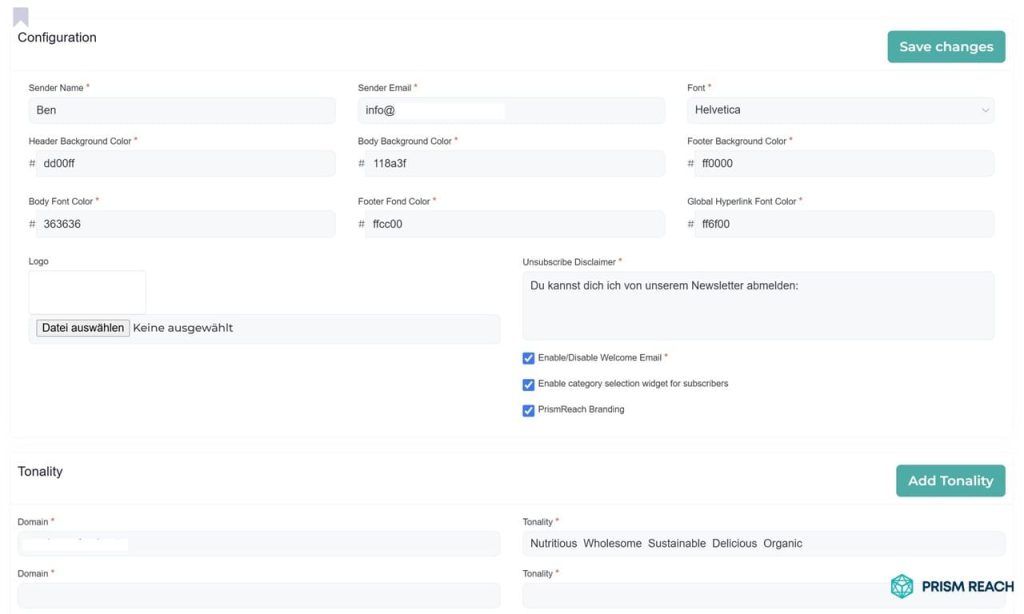
This user-friendly setup ensures that even those with limited technical expertise can leverage advanced email marketing strategies effectively.
Advanced Lead Enrichment
Prism Reach’s advanced lead enrichment capabilities allow you to enhance your email list with detailed subscriber information. This leads to:
- Detailed User Avatars: Creating comprehensive profiles based on location, engagement history, and predicted interests.
- Enhanced Targeting: More precise segmentation for targeted campaigns.
- Improved Engagement: Higher relevance and personalization lead to increased subscriber interaction.
By enriching your data, Prism Reach ensures your email campaigns are both targeted and effective, directly contributing to improved deliverability.
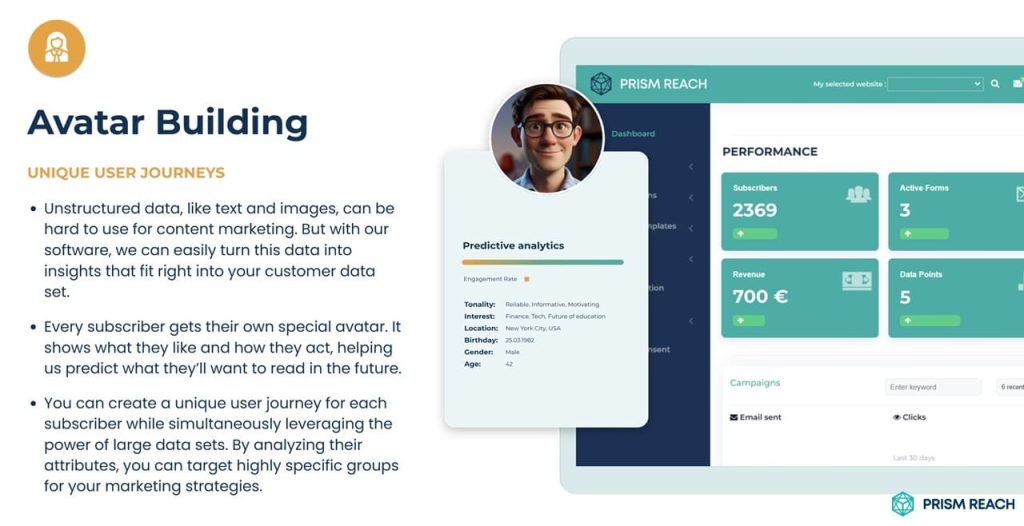
Potential Benefits of Prism Reach
- Increased Engagement: Publishers report up to 40% higher engagement rates due to the personalized nature of the content.
- Higher Revenue: Tailored advertising and efficient content targeting lead to higher monetization rates for published newsletters.
- Improved Productivity: Automation and AI-driven insights significantly reduce the time required to create and manage campaigns.
Practical Tips to Improve Deliverability
Improving email deliverability is an ongoing process that involves multiple strategies. Here are some practical tips to help you enhance your deliverability rates:
1. Authenticate Your Emails
Implement SPF, DKIM, and DMARC protocols to verify your identity as a sender. These authentication methods help prevent your emails from being spoofed and increase trust with ISPs. Steps to authenticate your emails include:
- Set Up SPF: Define which IP addresses are authorized to send emails on behalf of your domain.
- Configure DKIM: Add a DKIM signature to your emails to ensure content integrity.
- Implement DMARC: Establish policies for handling emails that fail SPF or DKIM checks.
Prism Reach automates the setup and maintenance of these protocols, ensuring your emails are always properly authenticated.
2. Focus on List Hygiene
Regularly clean your email list by removing inactive or invalid email addresses. A clean list reduces bounce rates and improves your sender reputation. Effective list hygiene practices include:
- Remove Hard Bounces: Immediately eliminate email addresses that result in hard bounces.
- Engage Inactive Subscribers: Send re-engagement campaigns to inactive subscribers or remove them if they remain unresponsive.
- Validate Email Addresses: Use email verification tools to ensure the accuracy of your subscriber data.
Prism Reach’s advanced lead enrichment and list management features automate much of this process, ensuring your list remains clean and engaged.
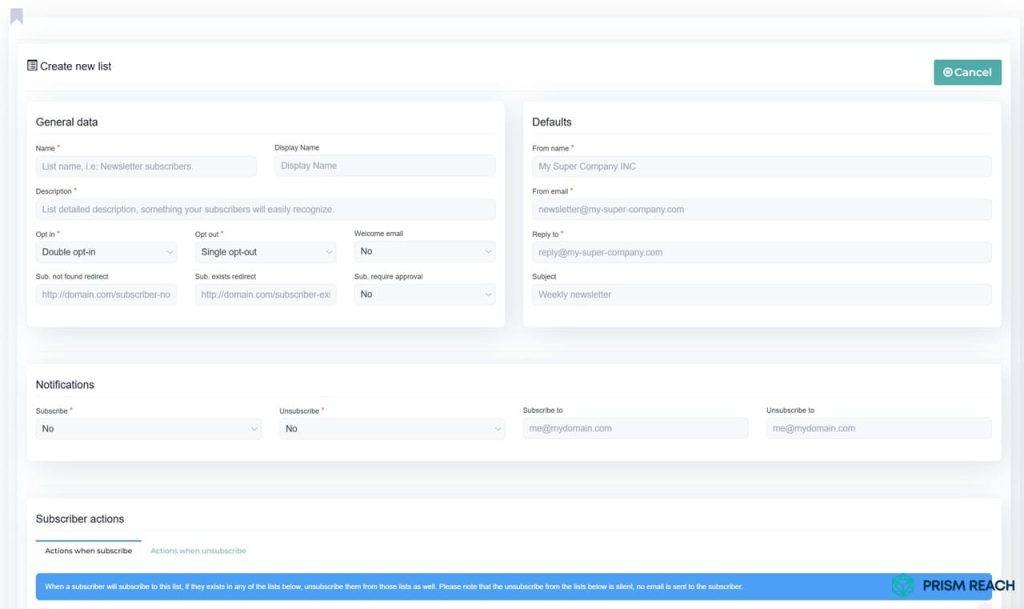
3. Prioritize Content Quality
Create engaging, relevant content that your subscribers want to interact with. High-quality content leads to better engagement rates, signaling to ISPs that your emails are valuable. Tips for prioritizing content quality include:
- Craft Compelling Subject Lines: Use clear and enticing subject lines to increase open rates.
- Provide Valuable Content: Ensure your email content offers real value to your subscribers, whether through information, discounts, or entertainment.
- Maintain Consistent Branding: Use consistent colors, fonts, and messaging to build brand recognition and trust.
- Optimize for Mobile: Ensure your emails are mobile-responsive to accommodate the growing number of mobile users.
Prism Reach’s AI-powered personalization helps create relevant and engaging content tailored to each subscriber’s preferences, enhancing content quality and engagement.
4. Monitor Engagement Metrics
Keep a close eye on open rates, click-through rates, and unsubscribe rates. These metrics provide valuable insights into the health of your email program and help you identify areas for improvement. Key metrics to monitor include:
- Open Rates: Indicates how many subscribers are opening your emails.
- Click-Through Rates: Measures how many subscribers are engaging with your content.
- Unsubscribe Rates: Reflects how many subscribers are opting out of your emails.
- Spam Complaints: Tracks how many subscribers are marking your emails as spam.
Tools like Prism Reach offer real-time analytics, allowing you to monitor these metrics and make data-driven decisions to improve your email performance.

5. Optimize Send Frequency and Timing
Find the optimal frequency and timing for sending emails to avoid subscriber fatigue while maintaining engagement. Tips for optimizing send frequency and timing include:
- Test Different Frequencies: Experiment with various send frequencies to determine what works best for your audience.
- Use Predictive Analytics: Leverage tools like Prism Reach to predict the best send times for individual subscribers based on their behavior and preferences.
- A/B Test Send Times: Conduct A/B tests to identify the most effective times for sending your emails.
- Respect Subscriber Preferences: Allow subscribers to choose their preferred frequency and send times through preference centers.
By optimizing both the frequency and timing of your emails, you can enhance engagement and improve deliverability rates.
The Role of AI in Email Deliverability
Artificial Intelligence (AI) is revolutionizing email deliverability by providing advanced tools and insights that were previously unattainable. Here’s how AI can enhance your deliverability:
Predictive Analytics
AI can analyze past performance to predict future engagement, helping you tailor your sending strategy for maximum impact. Predictive analytics can:
- Forecast Engagement: Predict which subscribers are most likely to engage with your emails.
- Optimize Content: Determine which types of content resonate best with different segments of your audience.
- Enhance Targeting: Identify high-value subscribers and prioritize them in your campaigns.
Prism Reach utilizes predictive analytics to refine your email strategy, ensuring your campaigns are both effective and efficient.
Content Optimization
AI tools can suggest subject lines and content tweaks that are likely to improve engagement and avoid spam triggers, ensuring your emails resonate with your audience. Content optimization involves:
- Subject Line Suggestions: AI can generate and test subject lines to identify the most effective ones.
- Personalized Content: Tailor email content based on individual subscriber preferences and behaviors.
- Spam Filter Avoidance: Analyze content for potential spam triggers and recommend adjustments.
With Prism Reach’s AI-driven content optimization, your emails are crafted to maximize engagement and minimize the risk of being marked as spam.
Send Time Optimization
AI can determine the best time to send emails to individual subscribers, increasing the likelihood of engagement and boosting deliverability rates. Send time optimization includes:
- Personalized Send Times: Schedule emails based on when each subscriber is most likely to open and interact with them.
- Time Zone Adjustments: Automatically adjust send times based on the subscriber’s geographical location.
- Behavioral Insights: Use AI to analyze subscriber behavior patterns and identify optimal send times.
Prism Reach’s send time optimization ensures that your emails reach subscribers at the most opportune moments, enhancing engagement and deliverability.
List Segmentation
Advanced AI algorithms can segment your list based on complex behavioral patterns, ensuring more targeted and relevant communications. Effective list segmentation involves:
- Behavior-Based Segments: Group subscribers based on their interactions with your emails, such as opens, clicks, and conversions.
- Demographic Segments: Create segments based on demographic data like age, gender, location, and interests.
- Engagement Levels: Differentiate between highly engaged, moderately engaged, and inactive subscribers for tailored campaigns.
Prism Reach’s AI-driven segmentation capabilities allow you to create precise audience segments, enhancing the relevance and effectiveness of your email campaigns.
Real-Time Adjustments
AI can monitor deliverability metrics in real-time and make instant adjustments to your sending strategy, maintaining high deliverability rates. Real-time adjustments include:
- Adaptive Sending: Modify send volumes and frequencies based on real-time performance data.
- Immediate Issue Detection: Identify and address deliverability issues as they arise to prevent widespread problems.
- Dynamic Content Changes: Adjust email content on the fly to improve engagement based on real-time feedback.
Prism Reach leverages AI to provide real-time monitoring and adjustments, ensuring your email campaigns remain effective and deliverable at all times.
Tools like Prism Reach leverage AI to provide these advanced capabilities, making it easier for marketers to optimize their email deliverability effectively.
Common Deliverability Pitfalls to Avoid
Even with the best intentions, certain practices can harm your email deliverability. Here are some common pitfalls to watch out for:
- Purchasing Email Lists: Buying email lists can damage your sender reputation and lead to high bounce rates. Always build your list organically.
- Ignoring Engagement Metrics: Low open and click rates are early warning signs of deliverability issues. Regularly monitor these metrics to identify and address problems.
- Neglecting List Hygiene: Failing to remove inactive subscribers and invalid emails can hurt your deliverability over time. Implement regular list cleaning practices.
- Inconsistent Sending Patterns: Sudden spikes or drops in email volume can trigger spam filters. Maintain a consistent sending schedule.
- Overlooking Mobile Optimization: Non-responsive designs can lead to poor engagement and deliverability issues. Ensure your emails are mobile-friendly.
Avoiding these pitfalls requires vigilance and a commitment to best practices. Prism Reach helps mitigate these risks by providing tools for list management, engagement monitoring, and ensuring consistent sending practices.
Balancing Personalization and Deliverability
Personalization is key to engagement, but it needs to be balanced with deliverability considerations. Here’s how to strike the right balance:
- Use Dynamic Content Wisely: Personalize content based on subscriber data while maintaining a consistent email structure to avoid triggering spam filters.
- Segment Thoughtfully: Create targeted segments without over-segmenting, which can lead to inconsistent sending patterns and potential deliverability issues.
- Test Extensively: Ensure personalized elements render correctly across different email clients through thorough testing.
- Monitor Engagement Closely: Keep track of how personalization affects your engagement metrics and adjust accordingly.
Prism Reach excels in this area by offering advanced personalization capabilities while maintaining high deliverability standards. This ensures your emails are both engaging and reliably delivered.
Monitoring and Measuring Deliverability
Regular monitoring is essential for maintaining high email deliverability. Here are key metrics to track:
- Open Rates: Indicates how many subscribers are opening your emails. A sudden drop can indicate deliverability issues.
- Bounce Rates: Monitor both hard and soft bounces closely. High bounce rates can damage your sender reputation.
- Spam Complaints: Even a small increase can significantly impact your sender reputation. Keep track of how often your emails are marked as spam.
- Inbox Placement Rates: Provides direct insight into where your emails are landing, whether in the inbox or spam folder.
- Engagement Metrics: Open rates, click-through rates, and unsubscribe rates offer valuable insights into the health of your email program.
Tools like Prism Reach offer real-time monitoring, allowing you to address issues promptly before they escalate. This proactive approach is crucial for maintaining consistently high deliverability rates. By leveraging Prism Reach’s analytics, you can gain comprehensive visibility into your email performance and make informed decisions to enhance your deliverability.
FAQ
Conclusion
Mastering email deliverability is a critical aspect of successful email marketing. It involves a combination of technical setup, reputation management, content optimization, and strategic sending practices. By understanding the key factors that influence deliverability and implementing advanced strategies like tiered engagement segmentation and AI-powered personalization, you can significantly enhance your email performance.
Tools like Prism Reach play a vital role in this process, offering sophisticated AI-driven features that automate and optimize various aspects of your email campaigns. From seamless integration and advanced lead enrichment to real-time analytics and personalized content creation, Prism Reach provides the tools necessary to achieve and maintain excellent deliverability rates.
Remember, email deliverability is not a one-time effort but an ongoing journey. By staying informed about best practices, leveraging advanced technologies, and continuously monitoring your email performance, you can ensure that your messages consistently reach and resonate with your audience, driving meaningful engagement and achieving your marketing goals.
As we look to the future, I’m excited about the continued advancements in AI and machine learning that will further enhance our ability to deliver the right message to the right person at the right time. By staying informed, embracing new technologies, and always putting your subscribers first, you’ll be well-positioned to succeed in the ever-evolving world of email marketing.
In conclusion, mastering email deliverability is a critical skill for any modern marketer. It’s a complex challenge, but with persistence, the right tools, and a commitment to best practices, it’s one that you can certainly overcome. Here’s to your future email marketing success!
Sources
- Klaviyo: Email Deliverability Tips
- BlocFree: Improve Email Deliverability
- EmailToolTester: Email Deliverability Best Practices
- SmartLead: Email Deliverability Best Practices